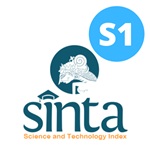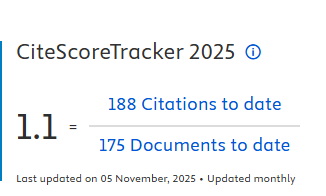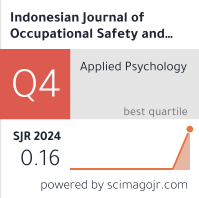Fatigue Assessment: Study Based on Physical Activity and Muscular Strength at Sedentary Workers

Downloads
Introduction: Work fatigue is often a neglected problem because the symptoms are not specific and not visible directly to the naked eye. Occupational fatigue itself contributes more than 60% of all occupational accidents that occur in the workplace. The high rate of occupational fatigue that can contribute to work accidents is very interesting to be studied further related to the causal factors, including physical activity and muscular strength. The purpose of this study was to analyze the effect of physical activity and muscular strength with the incidence of fatigue in sedentary workers at Kalla Group located in Makassar, South Sulawesi. Method: The research is cross sectional study with samples in this study were sedentary workers who had relatively similar workloads and lifestyles which were then selected through simple random sampling calculations. This research uses ordinal regression statistical tests. Result: The test results obtained are p-value (p = 0.046) which means there is a significant relationship between fatigue and muscle strength, but there is no relationship between fatigue and exercise habits, no relationship between fatigue and smoking habits, no relationship between fatigue and staying up late and no relationship between fatigue and sitting time in a day on sedentary workers at Kalla Group, Makassar, South Sulawesi. Conclusion: Workers need to do light muscle stretching so that workers do not get tired easily when working in a static position for a long time and workers also need to adopt a healthy lifestyle.
Aprianti, A. and Agustin, D.N. (2018) ‘Status Gizi, Kebiasaan Olahraga Dan Masa Kerja Dengan Kelelahan Kerja pada Pekerja (Studi di Instalasi Gizi RSUD Dr. H. Moch. Ansari Saleh Banjarmasin)’, Jurusan Gizi Politeknik Kesehatan Banjarmasin, 1(2), pp. 39–51.
Cunningham, T. R. et al. (2022) ‘Work-related Fatigue: A Hazard for Workers Experiencing Disproportionate Occupational Risks’, American Journal of Industrial Medicine, 65(11), pp. 1913–925. doi:10.1002/ajim.23325.
Farisa, D., Amir, N. and Jafar, M. (2017) ‘Evaluasi Kekuatan Otot Lengan Petani Kelapa Sawit Kecamatan Simpang Kanan Kabupaten Aceh Singkil’, Jurnal Ilmiah Mahasiswa Pendidikan Jasmani, Kesehatan dan Rekreasi Fakultas Keguruan dan Ilmu Pendidikan Unsyiah, 3(2), pp. 105–115.
Febriyanto, K., Gunawan, M.C. and Amalia, N. (2019) ‘Hubungan Kebiasaan Merokok dengan Kelelahan Kerja pada Petugas Pemadam Kebakaran Kota Samarinda’, Jurnal Dunia Kesmas, 8(1), pp. 19-24.
Haetami, M. and Triansyah, A. (2021) ‘The Effect of Massage and Active Stretching on Speeding Up Blood Lactic Acid Recovery’, Halaman Olahraga Nusantara (Jurnal Ilmu Keolahragaan), 4(2), pp. 326-338
Hendrayati, Rowa, S.S. and Mappeboki, S. (2009) ‘Gambaran Umum Asupan Zat Gizi, Status Gizi dan Produktivitas Karyawan CV. Sinar Matahari Sejahtera di Kota Makassar’, Media Gizi Pangan, 7(1), pp. 35-40.
Hermawan, B., Haryono, W. and Soebijanto, S. (2017) ‘Sikap, beban kerja dan kelelahan kerja pada pekerja pabrik produksi aluminium di Yogyakarta’, BKM Journal of Community Medicine and Public Health, 33(4), pp. 213–218.
Ismiarni, H. et al. (2017) ‘Hubungan Postur Kerja dengan Kejadian Kelelahan Otot Punggung pada Pekerja Mebel Bagian Pengamplasan Di PT. X Jepara’, Jurnal Kesehatan Masyarakat (e-Journal), 5(1), pp. 2356–3346. Available at: http://ejournal-s1.undip.ac.id/index.php/jkm
Kawatu, P. and Lery, F. (2012) Bahan Ajar Kesehatan dan Keselamatan Kerja. Manado: FKM-Unsrat.
Li, H., He, W. and Liu, G. (2024) ‘Exercise habits and health behaviors on adolescent obesity’, Acta Psychologica, 245, p. 104199. https://doi.org/10.1016/J.ACTPSY.2024.104199
Medianto, D. (2017) Faktor-Faktor yang Berhubungan dengan Kelelahan Kerja pada Tenaga Kerja Bongkar Muat (TKBM) di Pelabuhan Tanjung Emas Semarang (Studi pada Pekerja TKBM Bagian Unit Pengantongan Pupuk). Undergraduate Thesis. Semarang: Faculty of Public Health Universitas Muhammadiyah Semarang.
Mokosuli, R., Jesephus, J. and Joseph, W. B.S (2016) ‘Hubungan Antara Aktivitas Fisik Dengan Kelelahan Kerja Pada Nelayan Di Kelurahan Malalayang 1 Timur Kecamatan Malalayang Kota Manado’, PHARMACON: Jurnal Ilmiah Farmasi, 5(3), pp. 218-221.
Newton Jr, R. L. et al (2013) ‘The Energy Expenditure of Sedentary Behavior: A whole Room Calorimeter Study’, PLoS One, 8(5), pp. 1–6.
Nugroho, G.K.T., Ulfah, N. and Harwanti, S. (2015) ‘Hubungan Sikap Kerja Dengan Kelelahan Kerja Pada Pekerja Laundry Di Kecamatan Purwokerto Utara Kabupaten Banyumas’, Jurnal Kesmasindo, 7(3), pp. 209–217.
Park, J.H. et al (2020) ‘Sedentary Lifestyle: Overview of Updated Evidence of Potential Health Risks’, Korean Journal of Family Medicine, 41(6), pp. 365-373.
Prakoso, I.D., Setyaningsih, Y. and Kurniawan, B. (2018) ‘Hubungan Karakteristik Individu, Beban Kerja, Dan Kualitas Tidur Dengan Kelelahan Kerja Pada Tenaga Kependidikan Di Institusi Kependidikan X’, Jurnal Kesehatan Masyarakat (e-Journal), 6(2), pp. 2356–3346. Available at: http://ejournal3.undip.ac.id/index.php/jkm.
Samara, S.S. and Nasir, N.M. (2024) ‘Faktor-Faktor yang Berhubungan dengan Kelelahan Kerja pada Dosen saat Pandemi COVID-19’, Jurnal Ilmu Kesehatan Masyarakat, 13(2), pp. 110–122.
Sari M.P, and Prasasti, C.I. (2020) ‘Overview of Workers’ Pulmonary Faal Conditions and Worker Actions at The End of The Final Scrub Industry X Surabaya’. Indonesian Journal of Public Health, 15(1), pp. 25-36.
Tarwaka. (2014) Keselamatan dan Kesehatan Kerja: Manajemen dan. Implementasi K3 di Tempat Kerja. Surakarta.: Harapan Press.
Tarwaka, Bakri, H.A. and Sudiajeng, L. (2004) Ergonomi untuk Keselamatan, Kesehatan Kerja dan Produktivitas. Surakarta: UNIBA Press.
Tesfaye, A. H. et al. (2023) ‘Prevalence and Associated Factors of Poor Sleep Quality among Industrial Workers in Addis Ababa, Ethiopia: Findings from a Cross-sectional Study’, BMJ Open, 13(10). Available at: https://doi.org/10.1136/BMJOPEN-2023-073340.
Tjahayuningtyas, A. (2019) ‘Faktor Yang Mempengaruhi Keluhan Musculoskeletal Disorders (MSDSs) Pada Pekerja Informal’, Indonesian Journal of Occupational Safety and Health, 8(1). https://doi.org/10.20473/ijosh.v8i1.2019.1-10
Triana, E. and Wahyuni, I. (2017) ‘Hubungan Status Gizi, Lama Tidur, Masa Kerja dan Beban Kerja Dengan Kelelahan Kerja pada Mekanik Di PT X Plant Jakarta’, Jurnal Kesehatan Masyarakat (e-Journal), 5, pp. 2356–3346. Available at: http://ejournal3.undip.ac.id/index.php/jkm.
Wahyono, H. and Sudibjo, P. (2019) ‘Hubungan Status Kebugaran Jasmani dan Status Gizi dengan Produktivitas Kerja Pekerja Pembuat Buis Beton’, Pendidikan Kesehatan dan Rekreasi FIK - UNY [Preprint]. https://doi.org/10.21831/medikora.v15i2.23203
Wennberg, P. et al. (2016) ‘Acute Effects of Breaking up Prolonged Sitting on Fatigue and Cognition: A Pilot Study’, BMJ Open, 6(2), p. e009630. https://doi.org/10.1136/BMJOPEN-2015-009630.

This work is licensed under a Creative Commons Attribution-NonCommercial-ShareAlike 4.0 International License.

In order to be accepted and published by The Indonesian Journal of Occupational Safety and Health, Author(s) who submit an article should complete all the review process. The copyright of received articles assigned to the The Indonesian Journal of Occupational Safety and Health and Department of Safety and Health, Universitas Airlangga as publishers of the journal. The intended copyright includes the rights to publish articles in various forms (including reprints).
The Editorial Team of The Indonesian Journal Of Occupational Safety and Health and Department of Safety and Health strive to ensure that no errors occur in the articles that have been published, both data errors and statements in the article.
Users of this website will be licensed to use materials from this website following the Creative Commons Attribution-NonCommercial-ShareAlike 4.0 International License. No fees charged. Please use the materials accordingly.
------------------------------------------------------------------------------------------------------------------------------------------------------------------------------------------
Attribution ” You must give appropriate credit, provide a link to the license, and indicate if changes were made. You may do so in any reasonable manner, but not in any way that suggests the licensor endorses you or your use.
NonCommercial ” You may not use the material for commercial purposes.
ShareAlike ” If you remix, transform, or build upon the material, you must distribute your contributions under the same license as the original.







 How to Submit Articles in OJS
How to Submit Articles in OJS

























